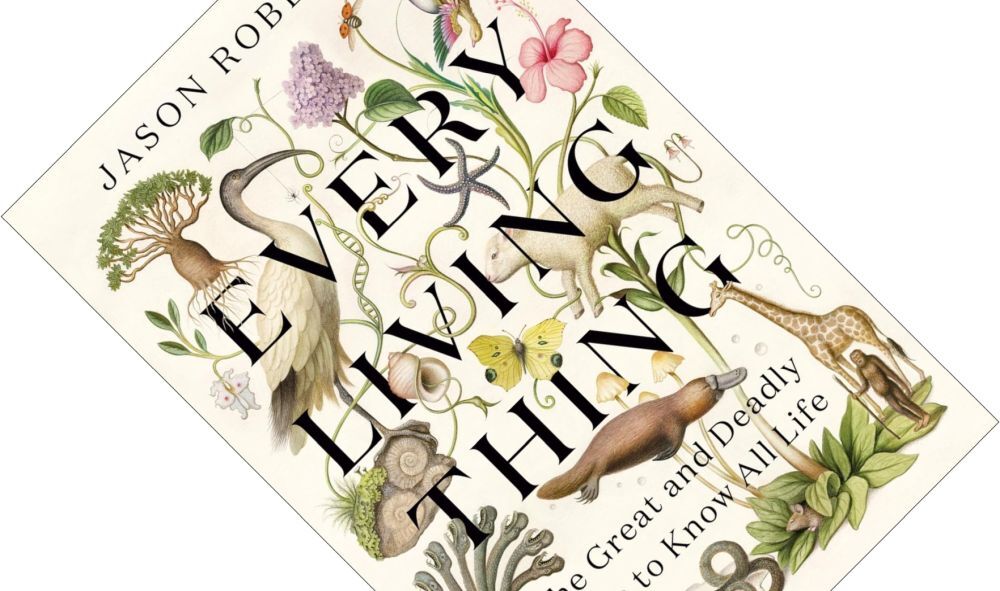#FossilFriday Mary Ann Woodhouse and the discovery of Iguanodon https://paleonerdish.wordpress.com/2025/02/10/mary-ann-woodhouse-and-the-discovery-of-iguanodon/ #EarthScience, #HistoryOfScience, #Iguanodon, #MaryMantell, #WomenInScience

#FossilFriday Mary Ann Woodhouse and the discovery of Iguanodon https://paleonerdish.wordpress.com/2025/02/10/mary-ann-woodhouse-and-the-discovery-of-iguanodon/ #EarthScience, #HistoryOfScience, #Iguanodon, #MaryMantell, #WomenInScience

Every Living Thing: The Great and Deadly Race to Know All Life is now out in paperback! An epic history of taxonomy across three centuries, this book charts the lives, works, and legacy of Linnaeus and Buffon.
#Books #BookReview #Bookstodon #Taxonomy #Linneaus #Buffon #Biography #HistoryOfScience #ScienceHistory #HistSci #Scicomm @bookstodon

Changing the Eurocentric narrative about the history of science – why multiculturalism matters
#IslamicHistory #IbnAlHaytham #HistoryOfScience #IslamicGoldenAge #Multiculturalism #Optics #Avicenna #IndigenousWisdom #AntiEurocentrism #ScienceHistory
https://the-14.com/changing-the-eurocentric-narrative-about-the-history-of-science-why-multiculturalism-matters/
The closing conference of the #FIREUSES - Burning Landscapes project will take place at the National Library of Portugal on 24 April. Throughout the day, main results will be presented combined with other perspectives and geographies of fire.
FREE ENTRY
Exploring Model Templates Across Disciplines
At the @tuberlin workshop “Large Language Models for HPSS” Maximilian Noichl presented #OpenAlexMapper—a tool to trace how model templates, concepts, and methods like #RandomForest spread across scientific disciplines over time.
His talk offered a compelling case for combining projective methods with large-scale bibliometric data.
https://maxnoichl.eu/full/talks/talk_BERLIN_April_2025/talkBERLIN.html#/section-3
Why the weasel testicles? Cambridge show explains medieval medicine https://www.theguardian.com/science/2025/mar/28/mercury-weasel-testicles-feature-uk-exhibition-medieval-medicine-curious-cases-cambridge-university-library #UniversityofCambridge #Historyofscience #Medicalresearch #Exhibitions #Medicine #England #Science #UKnews
It's publication day!
Enwogion o fri: Diversity Project 2023-2025
Our free #DiversityProject anthology for the #Bywgraffiadur has just dropped on KC Works. Over 40 authors contributed more than 60 articles about the most fascinating people in #Welsh #history you could possibly imagine.
We've covered #BAMEHistory #LGBTQ_ and #DisabilityHistory, #WomensHistory, #ArtHistory, the #HistoryOfScience, #HistoryOfReligion and #Wales
Frankly, there's not a single article in this collection that's not bound to be of interest to someone.
Get your own copy here as PDF or epub. And because we're in Wales, we even offer you two versions.
English: https://works.hcommons.org/records/dtb9c-bzm89
Cymraeg: https://doi.org/10.17613/mmwvm-ryh93
“The Story of Galaxy Clusters (and Abell 1)”
Really neat discussion of the history of astronomy.
Niche question for astronomers & historians of astronomy, particularly those at Harvard perhaps.
Can anyone tell me the birth & death dates of Edith F. Reilly, who worked with Bart Bok in the 1940's & co-authored the discovery paper on "small dark nebulae", now called "Bok globules"?
I've looked online, but have drawn a blank. They'd be good to have for my book.
A Brief History of the Miracle Bacterium

Explore the fascinating History of Science Museum and its treasures!
https://oxfordtraveltours.co.uk/directory/general/history-of-science-museum/

This week's #NewBooks at the library: Second-hand copies of The Theory of #Evolution: Principles, Concepts, and Assumptions from The University of Chicago Press; An Intimate History of Evolution: The Story of the #Huxley Family from Allen Lane (sans dustjacket); and Mind Over Magma: The Story of #IgneousPetrology from @princetonupress #Books #Scicomm #Bookstodon #HistoryOfScience #ScienceHistory #HistSci #EarthSciences #Geology
In a chapter of the book "A History of Physics", Quintino Lopes contributes to the #HistoryOfPhysics in the period between-wars, "examining relations between the physics laboratories of the Faculty of Sciences ogf teh University of Lisbon and the Instituto Superior Técnico on the one hand and the Laboratoire Curie, the @collegedefrance and other prestigious science institutions on the other hand".
https://link.springer.com/chapter/10.1007/978-3-031-26174-9_24
This week's #NewBooks at the library: Two more copies of the #CharlesDarwin correspondence project, obtained via second-hand booksellers at very reasonable prices; Multicellularity: Origins and Evolution from @themitpress; and Diana Preston's The Evolution of Charles Darwin from Grove Press
Today I learned that the person that proved the equations of general relativity (for empty space) always have well defined solutions was a french lady who died about three weeks ago.
Dr Yvonne Choquet-Bruhat proved this via results published in 1952 and 1969: https://en.wikipedia.org/wiki/Yvonne_Choquet-Bruhat #historyofscience #generalrelativity

Radical by Nature is out in paperback! This is an in-depth, intimate, and tremendously enjoyable biography of the long and remarkable life of Victorian naturalist #AlfredRusselWallace.
#Books #BookReview #Bookstodon #Evolution #HistoryOfScience #ScienceHistory #HistSci #Scicomm @bookstodon @princetonupress @princetonnature

“ Although the details of animal magnetism may sound absurd (and even morally dubious) to modern ears, within its context Mesmerism was very much in line with the latest scientific developments. In some ways, exciting experiments with invisible forces — gravity, electricity, magnetism, wondrous gases like hydrogen — defined the era. Unlike the occultists of the previous ages, Mesmer was striving to give his practices a rational scientific as opposed to a religious flavour. Indeed, although the magnetic fluid part did not work out, in an important sense, animal magnetism marked the beginnings of hypnosis and psychological suggestion. These are very real and possibly still clinically useful phenomena, as a recent resurgence in research shows.”

Isaac Newton’s beer mug to go on show in Royal Society exhibition in London https://www.theguardian.com/science/2025/mar/01/isaac-newtons-beer-mug-to-go-on-show-in-royal-society-exhibition-in-london #Historyofscience #RoyalSociety #IsaacNewton #Science #UKnews #Beer
Workshop: Large Language Models for the History, Philosophy & Sociology of Science
April 2–4, 2025
TU Berlin, Germany & Online
16 contributed talks on LLM use cases & implications
Free and open to the public—registration encouraged!
#AI #HistoryOfScience #PhilosophyOfScience #LLMs
Workshop "LLMs for HPSS" - TU ...